How to Write a Formal Email [10 Templates]
Melissa Williams
Sending a formal email is one of those things we put off doing.
Why? Because it can be a little uncomfortable.
But when reaching out to someone you don’t know, formal emails are the way to go. It’ll help you make a good first impression and come off as professional rather than too casual.
Below, we look at various ways to perfect your formal emails. We cover email format including subject lines, punctuations, email greetings, and sign-offs as well as pre-made formal email templates for various situations that you can copy and use today.
What Is a Formal Email?
A formal email is an email sent to someone either 1) you don’t know well or 2) in a position of authority.
Formal emails require proper format, language, and tonality. They serve a clear purpose and get the message across in a professional and polite manner.
Let’s take a look at some important elements for writing formal emails.
Tips for Writing a Formal Email
Use Formal English
Formal emails require formal English writing. This means including complete sentences, conjunctions, and transition words. Informal writing has fragments and comma splices. Informal messaging rarely contains conjunctions or transition words.
This is important in sales because you want to be perceived as professional and sharp.
Punctuation, paragraph form, greetings, and sign-offs also vary from formal to informal communication.
Here’s a graphic showing the complete list of differences:
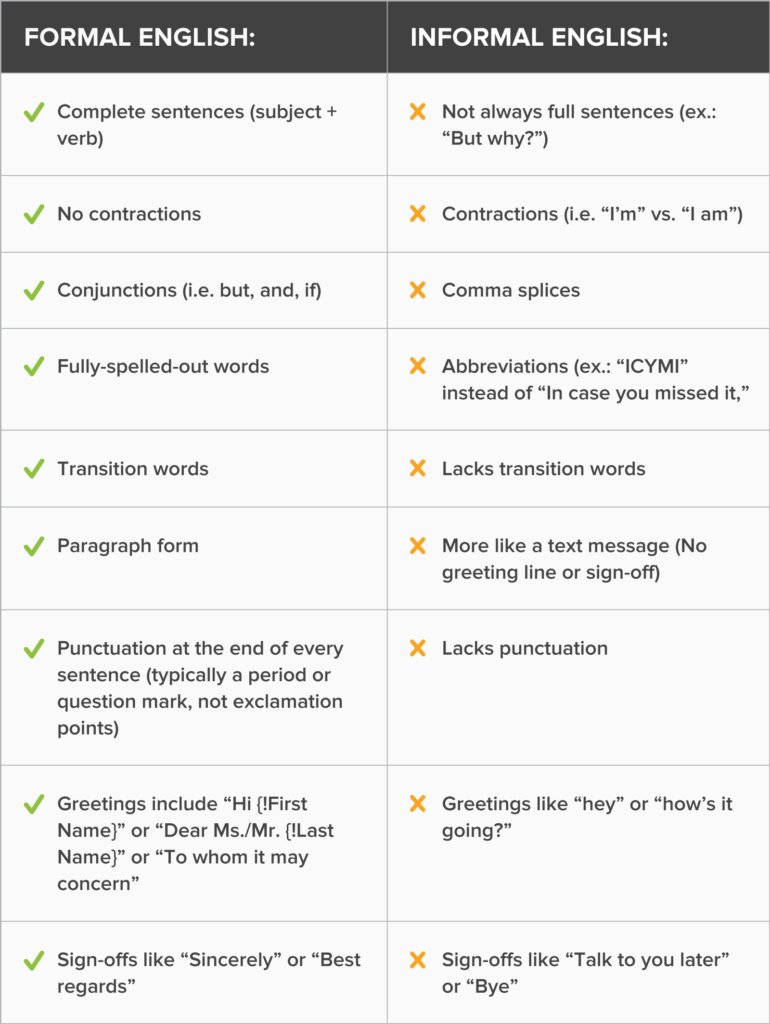
Use Proper Capitalization
The correct style of capitalization to use in your salutation is sentence case.
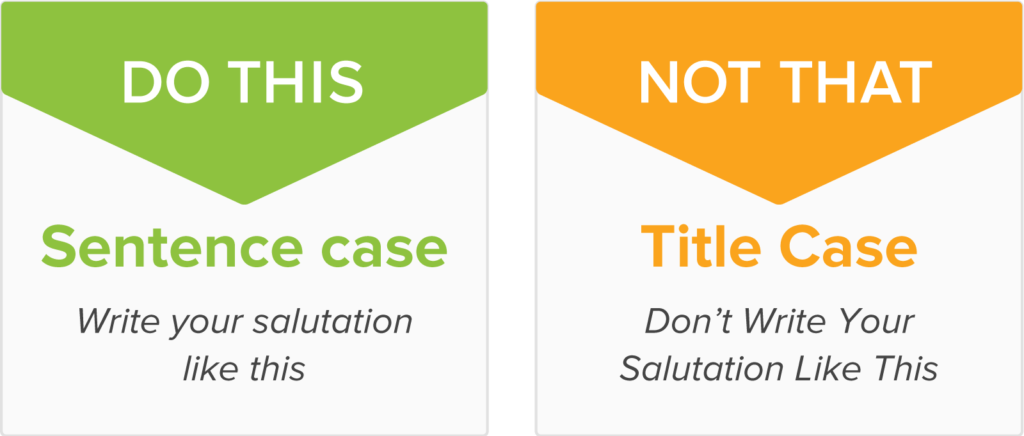
Here are the worst offenders for formal email greetings:
“Good Morning” → should be “Good morning”
“Good Afternoon”→ should be “Good afternoon”
“To Whom It May Concern” → should be “To whom it may concern”
The exception to the rule: proper nouns (i.e. people’s first names, Ms./Mr. + last name, or job title).
Write a Formal Subject Line
When writing formal emails, your subject line should be clear, concise, and accurate.
Describe what the email is about in one to five words. In fact, our research shows that this length yields higher open and reply rates.
Moral of the story: get to the point and don’t waste their time.
End Your Salutation With a Colon
When you’re writing a formal email, your salutation should end with a colon, not a comma.
When sending a professional email, the colon will change the tone of the message right from the get-go. In sales, this can help you gauge the attention of your recipient right off the bat.
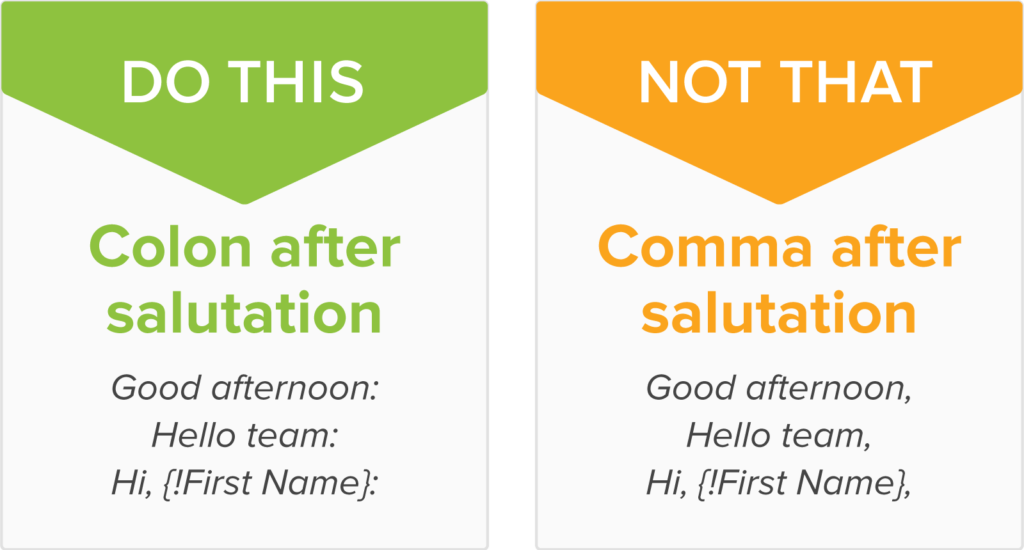
Use Short Sentences
Your formal emails should never have comma splices.
A comma splice is what happens when you join two complete sentences with a comma.
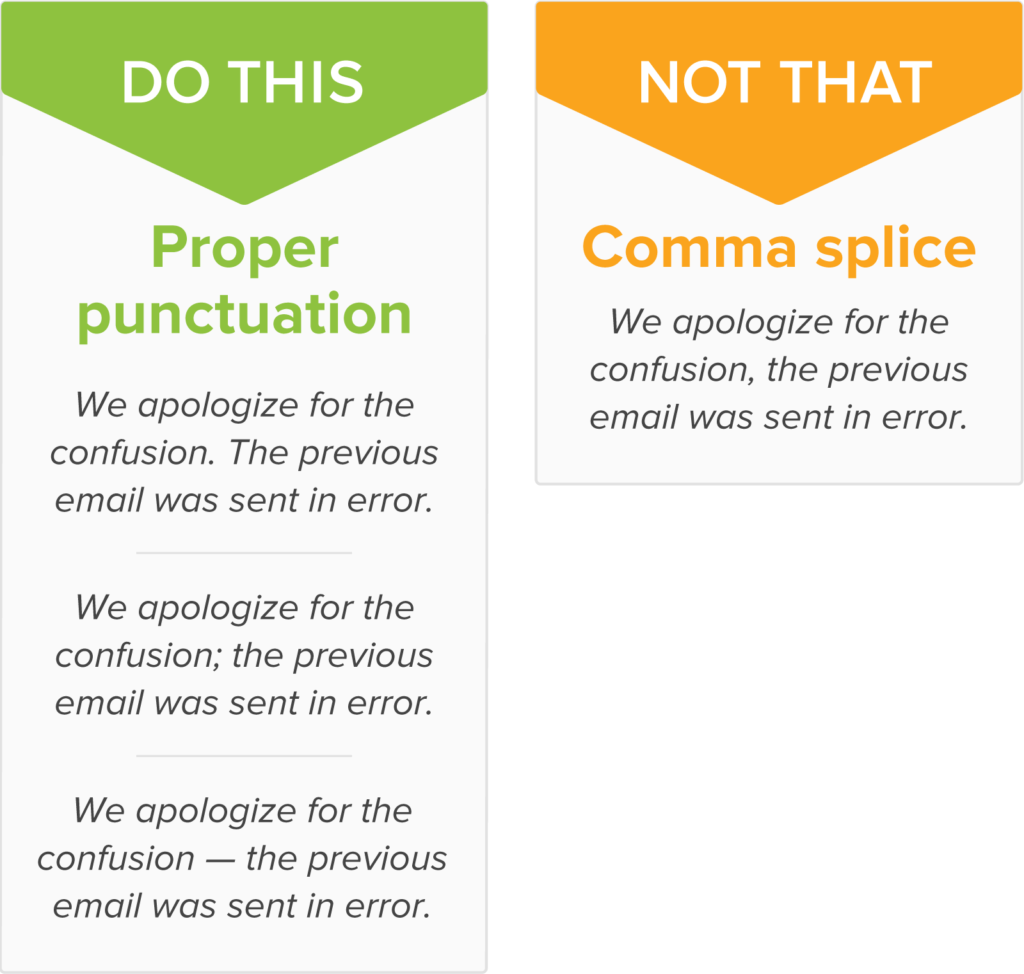
The takeaway: Comma splices are incorrect English grammar. They belong in text messages and other informal conversations.
Using short sentences in your email is a better sales strategy because you want prospects to understand your offering as quickly as possible. Be short and concise.
Use Proper Punctuation
Whenever you have a phrase or sentence in quotes, your end punctuation should go before the end quote.
This applies to commas that go on to continue sentences and periods that end them.
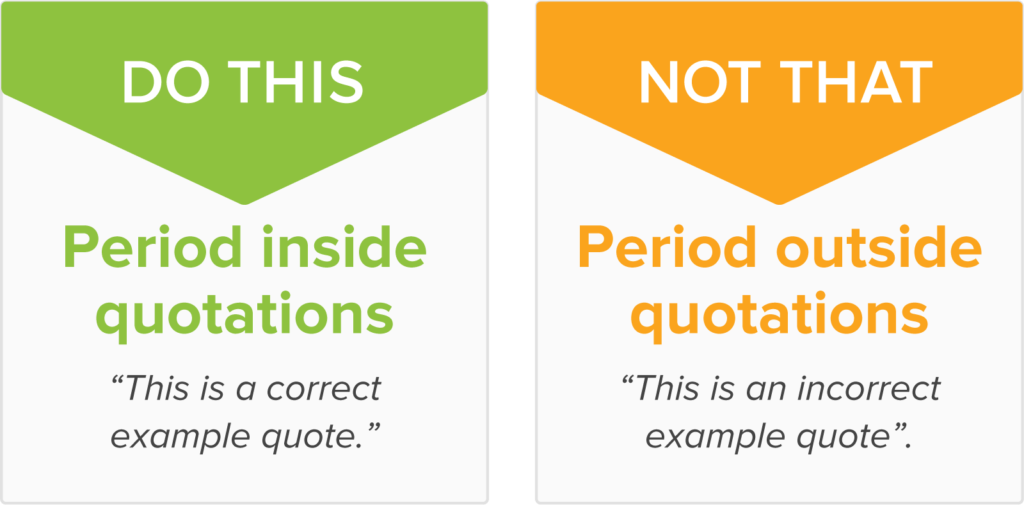
The exceptions to this rule are the following types of punctuation: semicolons, colons, and dashes. These should go outside of quotation marks (question marks are a little more tricky).
Formal Emails Should Be Direct and Persuasive
As Americans, we pride ourselves on being direct.
But we aren’t always.
How many times have you found yourself writing phrases like “I am writing to”?
This is a roundabout way of setting up your request. It’s very indirect.
You can’t afford to be sheepish when your entire email has seven seconds to get their attention.
I am writing to tell you that it’s time to stop using this phrase.
Other examples of phrases to avoid:
- “I wanted to ask you”
- “I wanted to let you know that”
- “I am reaching out to”
- “The reason for my email is that”
- “The purpose of this email is to”
Go ahead — jump right to that thing you’re winding up to.
Here’s why:
- Each phrase becomes self-evident with the text that follows. This makes you redundant where your messaging is most important: your first line.
- Being indirect doesn’t change the fact that you’re asking for or stating something uncomfortable. If anything, it shows hesitancy to leave your comfort zone.
- The email isn’t about you. It’s about what’s important to your recipient. Start with them.
What to do instead:
Start your draft with “I am writing to” to get your writing flow going. When you’re done, go back and delete that phrase. In most cases, you’ll still have a complete sentence without it. If you don’t, make a slight edit to turn what you have into a complete sentence.
End with a Formal Signature
Your email signature should include all contact information so the recipient knows where they can reach you.
Here’s an example of a formal email signature:
Name
Position | Company Name
Phone
Website
10 Formal Email Templates to Copy and Paste
Now, let’s look at some email templates that incorporate the necessary elements of a formal email format.
1. Formal Email Template for Making a Request
Subject Line Option A: Important – Action Required: {!Topic}
Subject Line Option B: Please Read: Needs Your Attention
Good morning, {!all/team/person}:
{!Give pertinent context here}.
{!Link for further reference}
My request to you: {!formal request in one sentence}.
- {!Action Item 1}
- {!Action item 2}
More info on {!topic}…
What it involves:
{!1 sentence summing up the context}.
This matters because:
-{!WIIFY — point 1}.
-{!WIIFY — point 2}.
-{!WIIFY — point 3}.
Thank you for your help!
Grab a sign-off line and tips on how to end an email here. Because writing “best” or “thanks” every time is a missed opportunity.
And here’s a similar professional email example to get you going with filling out the template:
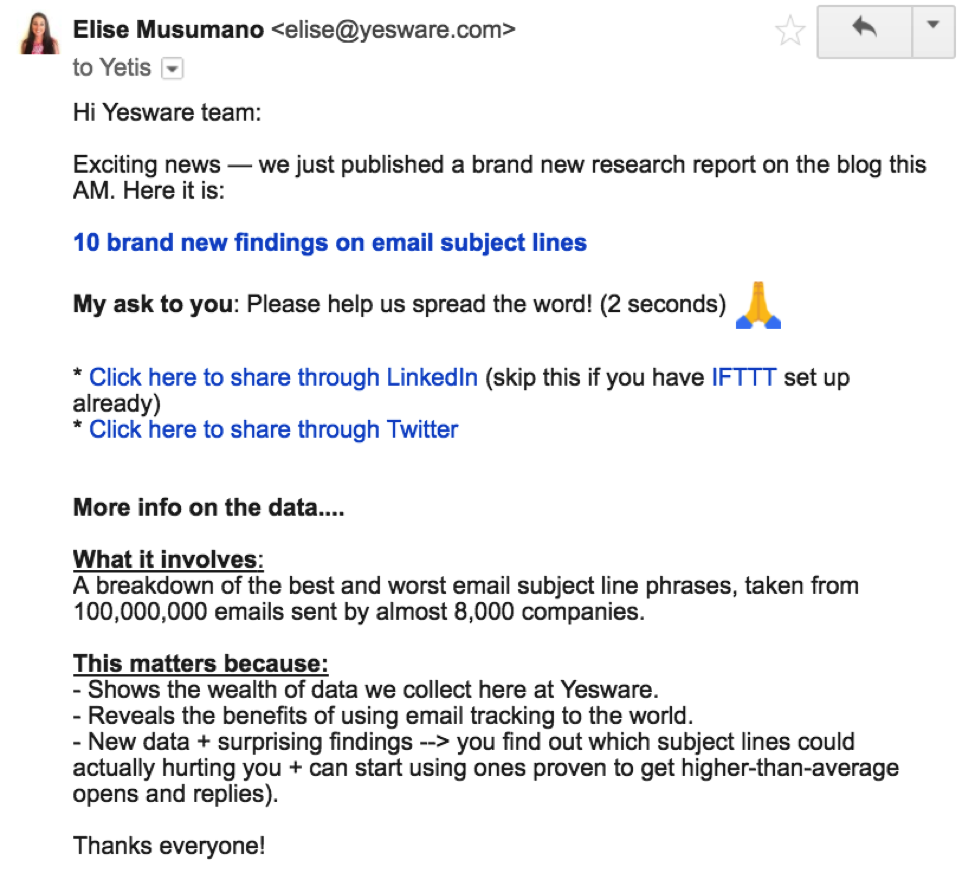
2. Email Template for Cold Outreach
Subject line: Articles for your commute home
Hi {!FirstName}:
The last few calls I’ve had with companies like yours who {!specific stats about the recipient’s company} have led me to research {!topic that could be a pain point for them}.
I thought you would appreciate these articles. I thought they did a great job at addressing {!pain point}:
- {!Link to content 1} – {!description of content 1}
- {!Link to content 2} – {!description of content 2}
- {!Link to content 3} – {!description of content 3}
If these resonated with you, let’s grab 15 minutes to see if {!Your Company} can help by {!proposed solution for solving pain point}.
Is there a day or time that generally works best for you?
3. Email Template for Giving a Formal Update
Subject Line: {!Topic} | {!Who/What It Affects}
Hi {!all/team/person}:
It is my pleasure to announce that {!change and people/focus it affects}.
{!Person or topic 1}
[Who/Why/What/Where/When. Tell a story here about how this change came to be.]
{!Person or topic 2}
[Who/Why/What/Where/When. Tell a story here about how this change came to be.]
[Final sentence reiterating change and how it affects readers.] Please join me in {!action}.
And here’s an example of the template above in real life. This business email announces promotions on our Customer Success team:
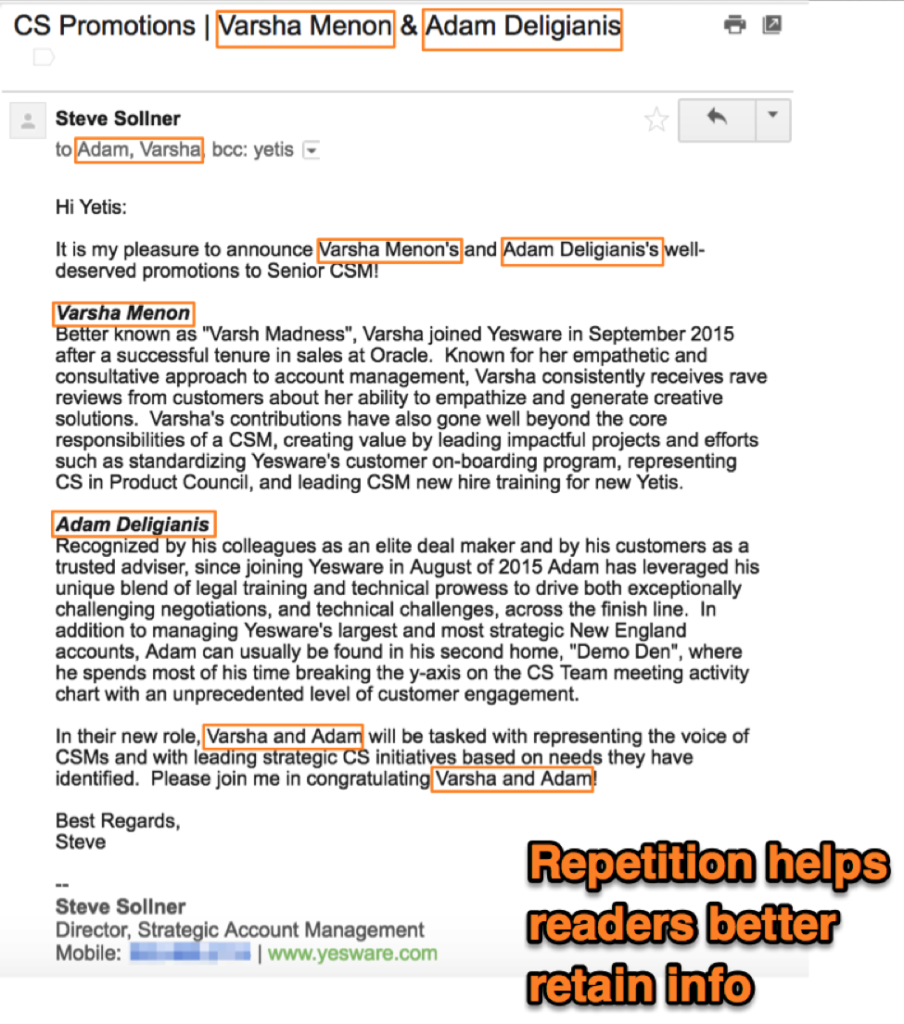
Tip: Always include your phone number and contact information in your email signature. For inspiration, here are 9 professional email signature examples.
4. Formal Email Template for an Apology
Subject line: {!focus area of issue}
Hello {!Customer Name},
{!We/team name} discovered an issue with {!what} {!when}.
What it means:
{!Negative affect to users}.
{!Note assuring users of things unaffected}
What happened:
As soon as our team identified the issue, it was addressed and remediated {!same day}.
What you can do:
{!Note}.
On behalf of {!team or company name}, we are very sorry for the inconvenience this causes you. I can assure you that we are analyzing how this issue occurred and ways to completely prevent recurrence in the future.
Thank you for your patience,
5. Email Template for a Termination
To whom it may concern:
Please be advised that, effective immediately, we have terminated your account with {!Company} due to {!reason}.
We regret having to take this action, but after our discussions with you {!Date & Time} regarding {!Wrongdoing}, we have seen no change in {!usage type}.
The manner in which you are using our service jeopardizes {!Thing 1} as well as {!Thing 2}.
Sincerely,
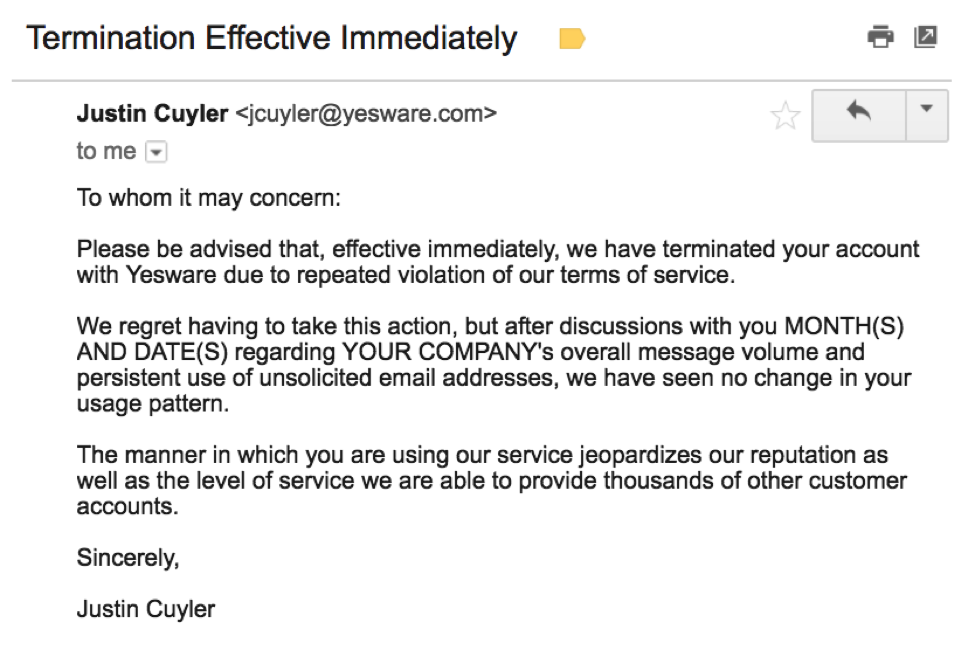
While the messaging is very direct, you need to be in a situation like this for legal purposes, clarity to the recipient, and finality. Language like “termination” and “effective immediately” show that this is a decision with no wiggle room for compromise.
Hint: If there were prior violations or instances where you gave warning, make sure to cite them.
6. Event Follow-Up Template
Subject Line: Great to meet you at {!Event}
Hi {!First Name}:
It was nice to meet you at {!Occasion where you met}. I loved learning more about {!Something discussed}.
I’m really interested to hear more about your role as {!Job title} at {!Company name}, as {!Reason why you’re interested}.
If you have time in the coming weeks, let’s {!Follow up action}.
I’m generally free on {!Days of the week}, if that works for you?
Looking forward to keeping in touch!
7. Formal Resignation Email Template
Dear {!First Name},
Please accept this message as formal notification that I am leaving my position at {!Company Name} effective {!Date}.
I would like to thank you for all of the wonderful opportunities I have been given at {!Company Name} and for everything you’ve taught me along the way.
During my last two weeks, please let me know what I can do to help make this transition as smooth as possible.
Wishing you and {!Company Name} continued success and I look forward to staying in touch.
Sincerly,
8. Formal Complaint Email Template
Hello {!First Name},
I am contacting you about {!Complaint} on {!Date}.
{!Reason for complaint.}
I am deeply disappointed about the outcome and hope to have the issue resolved. Please contact me at {!Contact information} with the appropriate resolution and next steps.
Thank you,
9. Formal Thank You Email Template (Interview)
Dear {!First Name},
Thank you so much for taking time out of your busy schedule to meet with me yesterday to discuss {!Position}. It was a pleasure to learn more about {!Role}, {!Company}, and the team.
I particularly enjoyed learning about {!Specific points} and it got me excited for {!Opportunity}.
Our conversion only increased my interest in this role and I’d be thrilled to use my {!Skills discussed} to accomplish {!Goals} for {!Company}.
Please don’t hesitate to reach out if you need any additional information or have any questions.
I look forward to hearing from you,
10. Formal Announcement Email Template
Dear Team,
I am thrilled in introduce you to {!Name} who is our new {!Position name}!
{!Name} will be working on {!Tasks/Projects} for {!Team name}.
Feel free to reach out to {!Name} at {!Contact Information} and say hi!
Best,
Tip: Grab 20 more formal email templates here –> Business Email Examples
How Yesware Can Help You Better Manage Email
Yesware can help your team better manage email with email templates that live in your inbox.
With email templates, you can save your top-performing emails in a template library that lives inside your inbox. You can personalize these templates in seconds with fill-in-the-blanks or dropdown options.
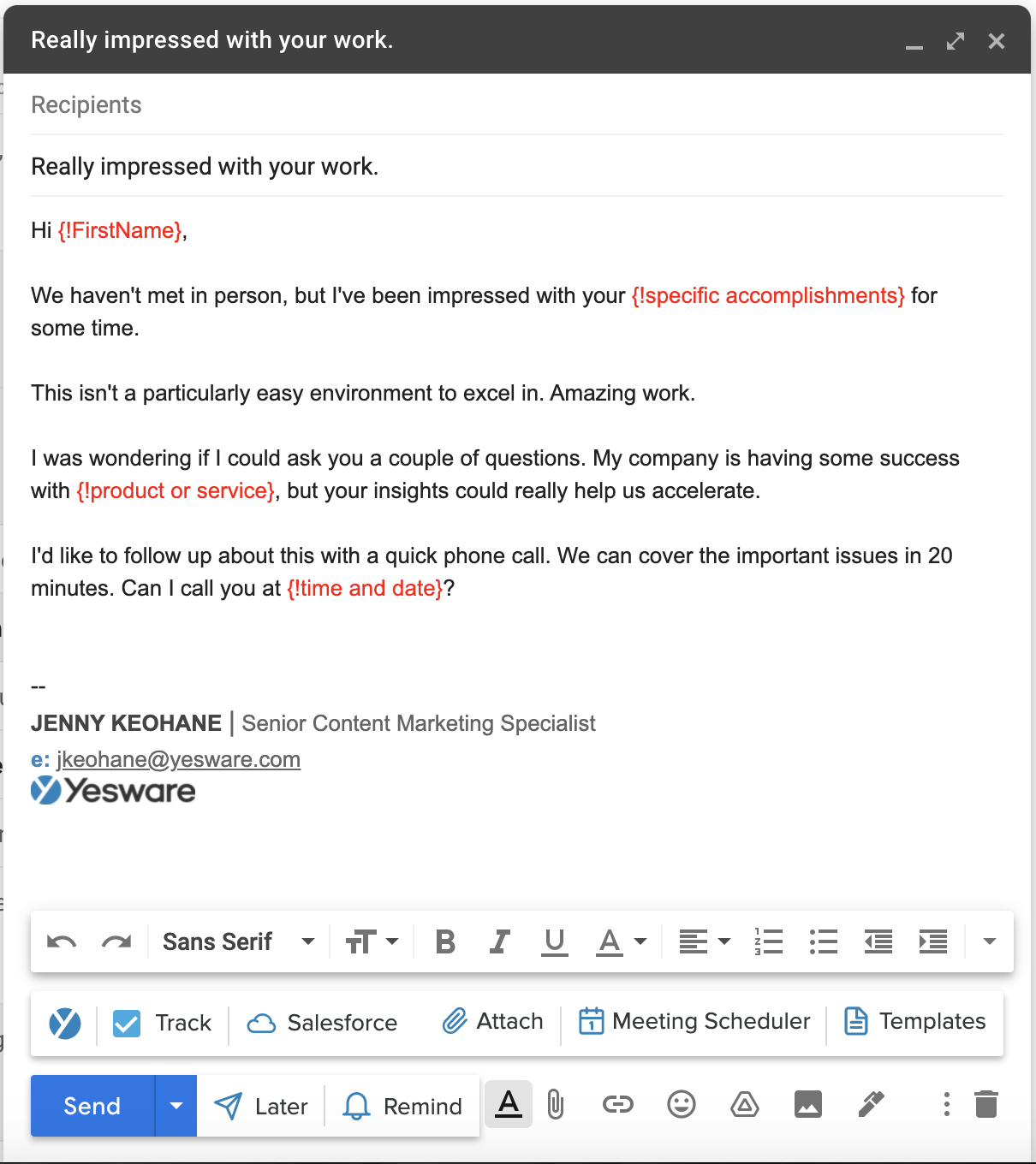
You can also send personalized templates to various users at once using campaigns.
Better yet, Yesware tracks all email sends so you’re always in the know of what is/isn’t working in your formal emails.
This guide was updated on May 18, 2022.
Get sales tips and strategies delivered straight to your inbox.
Yesware will help you generate more sales right from your inbox. Try our Outlook add-on or Gmail Chrome extension for free, forever!
Related Articles
Casey O'Connor
Jenny Keohane
Yesware
Sales, deal management, and communication tips for your inbox
![How to Write a Formal Email [10 Templates]](/blog/_next/image/?url=https%3A%2F%2Fwww.yesware.com%2Fwp-content%2Fuploads%2F2019%2F04%2FiStock-1192869283.jpg&w=1984&q=75)
